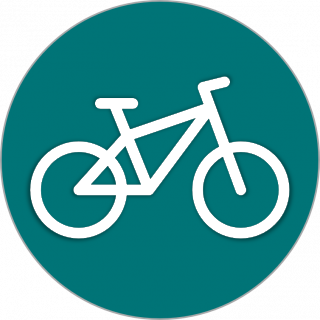
Clean & Efficient Transportation
Internal combustion engines from on-road transportation are the largest contributor to the City’s greenhouse gas emissions. The CAP’s Clean and Efficient Transportation Strategy leverages smart land use, planning, and other initiatives to encourage individuals to take transit, carpool, walk, bike, or commute alternatively, as opposed to driving alone.
In 2022, California regulators passed a rule restricting the sale of new gasoline powered vehicles within the state. This policy, along with other state and federal policies, will drastically reduce greenhouse gas emissions in the future. Complimentary to these statewide regulations, Encinitas’ local policies work toward reducing the frequency and distance vehicles travel in addition to preparing for a large increase in alternative fuel use within Encinitas.
To implement the Clean and Efficient Transportation Strategy, the CAP outlines the following goals: reduce vehicle miles traveled, reduce on-road fuel use, and increase the use of alternative fuels.
Implementation of the Clean and Efficient Transportation strategy is estimated to reduce the City’s greenhouse gas (GHG) emissions 4,481 metric tons of carbon dioxide equivalent (MTCO2e) by 2020 and 5,900 MTCO2e by 2030.
Explore the sections below to learn about the City’s planned and ongoing actions to achieve these reductions.
Reduce VMT
Reduce Vehicle Miles Traveled
Vehicle miles traveled (VMT) data shows how much people are driving in a given timeframe. We can reduce our community’s VMT by choosing transportation options like walking, biking, taking public transit, and carpooling to reduce the number of miles we drive alone. In 2012, the total VMT in Encinitas was approximately 1.4 million miles per day, which equates to 538 million miles traveled in that year.
UNIT | Vehicle miles traveled (VMT) is a measurement that estimates the total amount of miles vehicles travel within a certain area and in a given timeframe. The City measures VMT for Encinitas annually. | VMTVehicle Miles Traveled |
Vehicle miles traveled (VMT) is a measurement that estimates the total amount of miles vehicles travel within a certain area and in a given timeframe. The City measures VMT for Encinitas annually. | VMTVehicle Miles Traveled |
Last updated July 10, 2024
CET-1: Complete and Implement the Citywide Active Transportation Plan
Citywide Active Transportation Plan
CAP Measure CET-1 aims to implement the City’s Active Transportation Plan (ATP.) An ATP addresses local and regional bike and pedestrian travel by establishing proposed biking and walking facilities and improvements to multimodal connections to public transit. Completion of the proposed bicycle and pedestrian projects established in the ATP would reduce emissions by an estimated 254 MTCO2e.
In 2023, the City completed the Modal Alternatives Plan (MAP), an implementation planning document for the ATP. The MAP prioritized all of the projects identified in the ATP and selected the top 35 bicycle and pedestrian projects that the City should implement first for maximum multimodal benefits. Citywide projects reflect the top 10 prioritized projects while the remaining 25 represent the top five bicycle or pedestrian projects within Encinitas' five communities. City staff continue to make progress installing active transportation projects
In 2024, the City made significant progress on updating the Mobility Element of the City's General Plan. The Planning Commission reviewed the draft Mobility Element in November 2024 and recommended City Council adoption with suggested revisions. The Mobility Element includes updated goals and policies, multimodal networks, and a framework to implement SB 743, transitioning from Level of Service to Vehicle Miles Travelled for transportation impact analysis. The last Mobility Element update occurred in 1989, and this current update will provide a long-term blueprint for transportation decision-making while supporting the City's effort to expand mobility options and reduce climate impacts. The Draft Mobility Element and Environmental Impact Report (EIR) for the Mobility Element Update was released for public review in September 2024. To access these documents or learn more about the Mobility Element click here.
The City continues to prioritize data-driven decision making for tracking commuter mode shifts to biking and walking to evaluate the success of CAP measures. Building on the monitoring initiatives begun in 2023, the City has integrated these considerations into both the Mobility Element Update and ongoing Climate Action Plan implementation efforts.
Last updated May 12, 2025
CET-2: Implement a Local Shuttle System
Local Shuttle System
The City’s Climate Action Plan (CAP) estimated that adding new local transit options could save 365,000 vehicle miles traveled (VMT) in 2020 and 875,000 VMT in 2030. This would result in an estimated greenhouse gas (GHG) emissions reduction of approximately 130 metric tons of carbon dioxide equivalent (MTCO2e) and 178 MTCO2e, respectively. In 2014, the City completed a Transit Feasibility Study that recommended implementing new local transit routes to serve the Highway 101 corridor, education facilities in the city, and the Encinitas COASTER station. Since the adoption of the CAP, the City has been exploring potentially viable public transit options, including rideshare programs that may be served by microtransit electric vehicles. Microtransit is an on-demand transportation system that provides an alternative to traditional route-based transit like buses and trains. Microtransit includes more flexible transportation modes like mini-shuttles, neighborhood electric vehicles, and shared ride hailing technology like Uber and Lyft.
In 2024, The City received and approved allocation of funding toward a Microtransit Study aimed at exploring innovative transit solutions to reduce VMT by evaluating and developing a local shuttle system to reduce greenhouse gas emissions. The Encinitas Microtransit Study would be funded through a combination of sources, including a $50,000 contribution from Fox Point Farms, a housing element project, and a $50,000 San Diego Community Power (SDCP) Member Agency Grant administered by the University of San Diego. The study may apply additional funding through the U.S. Department of Energy (DOE) Energy Efficiency and Conservation Block Grant (EECBG) Technical Assistance Program. It is anticipated that the study will commence in Spring 2025 and conclude in Fall/Winter 2025.
In 2020, the City actively collaborated with regional partners such as the San Diego Association of Governments (SANDAG), the North County Transit District (NCTD), and neighboring jurisdictions—including the cities of Solana Beach, Carlsbad, Del Mar, and Oceanside—to develop a sub-regional or local public transportation system related to this CAP measure. The partners assessed options including shared neighborhood electric vehicle (NEV) rideshare programs and more traditional programs such as shuttle buses providing service to and from transit centers to employment centers. Since CAP adoption, the City has actively searched for grants and other outside funding to support this measures. The City will continue these collaboration and investigative efforts as CAP implementation continues.
Last updated May 12, 2025
CET-3: Improve Traffic Flow
Reduce On-Road Fuel Use
Reducing road congestion and improving traffic flow can lead to decreases in vehicle fuel use and greenhouse gas emissions. CAP Measure CET-3 mandates retiming the City’s traffic signals, and installing roundabouts as two methods to achieve this. By 2020, the CAP aimed to retime 60 traffic signals and install three roundabouts. By 2030, the CAP commits to the installation of an additional four roundabouts to improve traffic flow. These actions would reduce GHG emissions by approximately 3,671 MTCO2e in 2020 and 1,241 MTCO2e in 2030.
Highway 101 and El Portal Street was completed as part of the first phase of the Leucadia Streetscape project. Three other proposed roundabouts have completed the design phase. Construction on two of these roundabouts are planned to be constructed in 2025 —located along North Coast Highway 101 at the Jupiter Street and Grandview intersections. The third roundabout will be constructed at Leucadia Boulevard and Hygeia Avenue once grant funding is obtained.
Since the goals for on-road fuel use were established in the CAP in 2018, the City has shifted its focus to installing mobility infrastructure to promote the use of active transportation and reduce on-road fuel use, rather than adjusting traffic signal timing. That said, the City’s Traffic Division continually monitors all of the City’s traffic signals and regularly makes small adjustments to improve traffic flow and pedestrian crossing as warranted.
Last updated July 10, 2024
Increase Use of Alternative Fuels
Drive Electric Vehicles
Vehicles that run on electricity produce fewer emissions than vehicles that run on gasoline or diesel. By supporting a network of electric vehicle charging stations (EVCS), the City can help facilitate the switch to vehicles that run on electricity. Thus, CAP Measure CET-4 and CET-5 require the installation of EVCS at both residential and non-residential developments, respectively.
Last updated July 10, 2024
CET-5: Require Commercial Electric Vehicle (EV) Charging Stations
Commercial EV Charging Stations
Also in November 2019, City Council adopted an ordinance enacting a new regulation requiring new commercial developments to install electric vehicle charging stations (EVCS) at eight percent of the total number of parking spaces, effective January 1, 2020. This requirement was readopted concurrent with the incorporation of the state’s triannual code amendment updates, effective January 1, 2023. As a result of this code, the CAP estimated that 150 EVCS will be installed by 2020 and 490 EVCS would be installed by 2030 at new commercial developments. Meeting these goals will decrease greenhouse gas emissions by approximately 440 MTCO2e by 2020 and 3,582 MTCO2e by 2030.
As of 2024, there were 39 publicly available charging stations in Encinitas. While the ordinance is in place and being enforced, it is evident that commercial development may be occurring at a slower pace than anticipated by the CAP.
A new web app has been created for residents and visitors in Encinitas to easily locate all publicly available charging stations. Visit the site to see all the chargers in Encinitas!
Last updated May 12, 2025
Increase Use of Alternative Fuels
EV Charging Station Master Plan
In March 2023, the City adopted the Electric Vehicle Charging Station (EVCS) Master Plan in support of the City’s Climate Action Plan Goal 4.3 to Increase the Use of Alternative Fuels. The EVCS Master Plan evaluated and located existing EVCS within a five-mile radius of the City, conducted a needs assessment, defined future charging station location alternatives, and developed a plan to install EV charging stations throughout the community to support residents in transitioning to clean transportation options.
As of 2021, according to the Master Plan, around 2,900 electric vehicles (EV) were registered in Encinitas, approximately 5.5 percent of all vehicles registered in Encinitas. EV registrations are projected to increase to 3,500 by 2025 and to 15,000 by 2030. The EVCS Master Plan recommends that 120 charging stations be installed by 2025 and 281 charging stations be installed by 2030 in order to meet future demand for EV charging.
Proposed EV charging station sites in the plan include popular public destinations such as parks and beaches, sites along major commuter corridors, and parking lots for retail centers. The EVCS Master Plan recommended that the City utilize local, state, and federal EV charging regulations and incentives to require and encourage employers, multifamily, and commercial property owners to provide EV charging for the community. Check out the plan to learn more!
Last updated July 10, 2024
MCET-2: Adopt a Municipal Employee Telecommute Policy
Municipal Telecommute Policy
When the City’s CAP was updated in 2020, CAP Measure MCET-2 was added, making it the CAP's 20th measure. With this measure, the City has pledged to develop and implement a telecommuting policy for City employees. It assists in decreasing the City's overall greenhouse gas (GHG) emissions by reducing the number of vehicle miles traveled by City employees. The City’s CAP estimated that this measure would avoid 170,000 miles of commuting to and from municipal facilities and reduce GHG emissions by 50 metric tons of carbon dioxide equivalent (MTCO2e) in 2030.
The initial phase of the policy launched in the summer of 2022, giving City employees the option to telecommute one day per week. In 2023, the program was expanded to allow City employees the choice to telecommute one day per week on their four day week and two days per week on their five day week on a 9/80 schedule. The ability to telecommute is contingent on job function and management approval. For example, Public Works crews must be onsite to conduct maintenance in the field and cannot telecommute.
In 2024, there was a commuter survey sent to City employees. The workplaces represented in the survey results were City Hall, Public Works, San Diego Water District, Fire Stations, Marine Safety and Community and Senior Center. About 65% of respondents work a 9/80 schedule with 1 day off per pay period. The single-occupancy vehicle (SOV) rate of respondents is roughly 83% of respondents. The San Diego SOV average is 80%.
Last updated May 12, 2025
Vehicle Miles Traveled
How You Can Help
Last updated September 28, 2022






